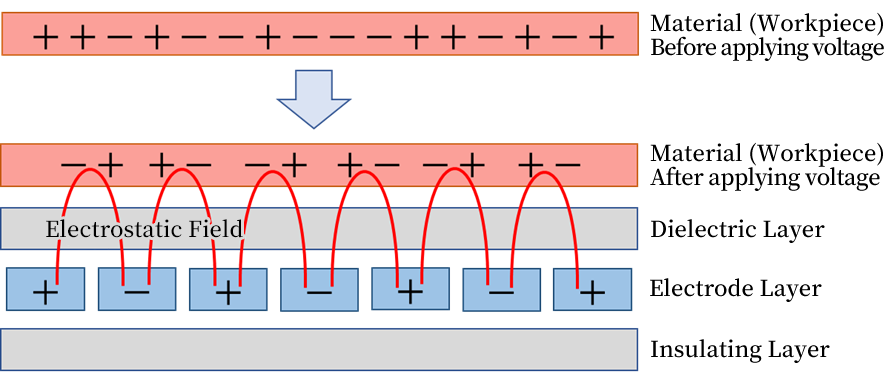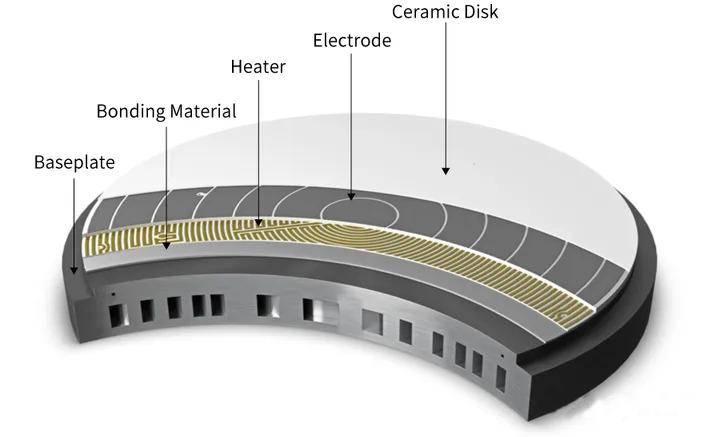
- English
- Español
- Português
- русский
- Français
- 日本語
- Deutsch
- tiếng Việt
- Italiano
- Nederlands
- ภาษาไทย
- Polski
- 한국어
- Svenska
- magyar
- Malay
- বাংলা ভাষার
- Dansk
- Suomi
- हिन्दी
- Pilipino
- Türkçe
- Gaeilge
- العربية
- Indonesia
- Norsk
- تمل
- český
- ελληνικά
- український
- Javanese
- فارسی
- தமிழ்
- తెలుగు
- नेपाली
- Burmese
- български
- ລາວ
- Latine
- Қазақша
- Euskal
- Azərbaycan
- Slovenský jazyk
- Македонски
- Lietuvos
- Eesti Keel
- Română
- Slovenski
- मराठी
- Srpski језик
Demystifying Electrostatic Chuck (ESC) Technology in Wafer Handling
2024-08-01
1. What is an ESC?
An ESC utilizes electrostatic forces to securely hold wafers or substrates within the vacuum environment of processing equipment. This method eliminates the potential for damage associated with traditional mechanical clamping methods, which can scratch delicate surfaces or induce stress fractures. Unlike vacuum chucks, ESCs do not rely on pressure differentials, enabling greater control and flexibility in wafer handling.

2. Three Principles of Electrostatic Adhesion
The attractive force generated by an ESC typically arises from a combination of three electrostatic principles: Coulomb force, Johnson-Rahbek force, and gradient force. While these forces can act individually, they often work synergistically to create a secure hold.
Coulomb Force: This fundamental electrostatic force arises from the interaction between charged particles. In ESCs, an applied voltage to the chuck electrodes generates an electric field, inducing opposite charges on the wafer and chuck surface. The resulting Coulomb attraction firmly holds the wafer in place.
Johnson-Rahbek Force: When a minute gap exists between the wafer and chuck surface, the Johnson-Rahbek force comes into play. This force, dependent on the applied voltage and gap distance, arises from the interaction of conductive particles within these micro-gaps with the charged surfaces. This interaction generates an attractive force that pulls the wafer into intimate contact with the chuck.

Gradient Force: In a non-uniform electric field, objects experience a net force in the direction of increasing field strength. This principle, known as gradient force, can be harnessed in ESCs by strategically designing the electrode geometry to create a non-uniform field distribution. This force draws the wafer towards the region of highest field intensity, ensuring secure and precise positioning.

3. ESC Structure

A typical ESC consists of four key components:
Disk: The disk serves as the primary contact surface for the wafer, precisely machined to ensure a flat, smooth interface for optimal adhesion.
Electrode: These conductive elements generate the electrostatic forces necessary for wafer attraction. By applying a controlled voltage, the electrodes create the electric field that interacts with the wafer.
Heater: Integrated heaters within the ESC provide precise temperature control, a crucial aspect in many semiconductor processing steps. This enables precise thermal management of the wafer during processing.
Baseplate: The baseplate provides structural support for the entire ESC assembly, ensuring proper alignment and stability of all components.**




